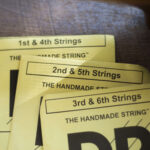When you’re ready to plug in and rock out on your electric guitar, one essential piece of gear often overlooked is the Electric Guitar Cord. It’s the unsung hero that carries your guitar’s signal to your amplifier, pedals, and recording interface. A quality cord can ensure pristine sound, while a poor one can lead to frustrating noise, signal loss, and even equipment failure. This guide will dive deep into everything you need to know about electric guitar cords to make informed decisions and keep your signal chain strong.
Understanding Electric Guitar Cords
At its core, an electric guitar cord, also known as an instrument cable or guitar lead, is a shielded cable designed to transmit the weak electrical signal from your guitar pickups to your amplifier or other effects units. Unlike speaker cables, which are designed for higher power output from amplifiers to speakers, instrument cables prioritize signal integrity and noise reduction.
Key Components of an Electric Guitar Cord
To understand what makes a good electric guitar cord, let’s break down its components:
- Conductor: This is the core of the cable, usually made of copper, that carries the electrical signal. Copper is preferred for its excellent conductivity.
- Insulation: The conductor is wrapped in an insulating material, typically plastic or rubber, to prevent signal leakage and short circuits.
- Shielding: This is a crucial layer that surrounds the insulation and conductor. It’s usually a braided or spiral-wrapped conductive material (like copper or tinned copper) designed to block electromagnetic interference (EMI) and radio frequency interference (RFI) that can introduce noise into your signal.
- Outer Jacket: The outermost layer protects the internal components from physical damage, moisture, and wear and tear. Materials like PVC or rubber are commonly used.
- Connectors: These are the metal plugs at each end of the cord that connect to your guitar and amplifier. Most electric guitar cords use 1/4″ (6.35mm) mono phone connectors, also known as TS (Tip-Sleeve) connectors.
Types of Electric Guitar Cords
While most electric guitar cords look similar, there are variations in quality and construction that impact performance and longevity.
Standard Instrument Cables
These are the most common type of electric guitar cord, readily available and suitable for most players. They offer a balance of quality and affordability for practice, rehearsals, and gigs.
Premium Instrument Cables
Stepping up from standard cables, premium options often feature higher-quality components for improved signal clarity and durability. This can include:
- Oxygen-Free Copper (OFC) Conductors: OFC is known for its superior conductivity and reduced signal degradation compared to standard copper.
- Denser Shielding: Braided shields offer better noise rejection than spiral shields. Some premium cables use multiple layers of shielding.
- High-Quality Connectors: Brands like Neutrik and Switchcraft are known for their robust construction and reliable connections.
- Durable Outer Jackets: Heavier-duty jackets can withstand more abuse and are ideal for frequent use and touring.
Low-Capacitance Cables
Capacitance is an electrical property that can subtly filter high frequencies in your guitar signal, potentially resulting in a loss of brightness. Low-capacitance cables are designed to minimize this effect, preserving the full frequency range of your guitar, especially important for players who value clarity and detail in their tone. These are often favored by players with longer cable runs or those using vintage-style guitars with brighter pickups.
Choosing the Right Electric Guitar Cord: Key Considerations
Selecting the best electric guitar cord for your needs involves considering several factors:
Length
The right cable length depends on your setup and playing environment.
- Shorter Cables (10-15 feet): Ideal for practice at home, small studios, or pedalboards where your amp is close by. Shorter cables minimize signal loss and are less prone to tangling.
- Longer Cables (20-30 feet): Better suited for stages, larger studios, or situations where you need more freedom of movement away from your amplifier. For longer runs, consider premium or low-capacitance cables to mitigate signal degradation.
Avoid using excessively long cables if you don’t need them, as they can increase capacitance and potentially introduce more noise.
Gauge (Thickness)
Cable gauge refers to the thickness of the conductor wire, typically measured in American Wire Gauge (AWG). Lower AWG numbers indicate thicker wires.
- Thicker Gauge (e.g., 20-24 AWG): Thicker conductors generally offer slightly better signal conductivity and can handle longer cable runs with less signal loss. However, they can also make cables less flexible.
- Thinner Gauge (e.g., 24-28 AWG): Thinner cables are more flexible and easier to handle, suitable for shorter runs and situations where flexibility is prioritized.
For most electric guitar cord applications, gauge is less critical than other factors like shielding and conductor material. Standard gauges are generally sufficient.
Shielding Quality
Shielding is paramount for reducing noise and interference in your guitar signal.
- Spiral Shielding: A common and cost-effective shielding type, offering decent noise rejection for general use.
- Braided Shielding: Provides superior shielding coverage and is more effective at blocking EMI and RFI, resulting in a quieter signal, especially in noisy environments. Braided shields are often found in premium cables.
- Double Shielding: Some high-end cables incorporate both braided and conductive polymer shields for maximum noise rejection.
If you play in environments prone to electrical noise or experience unwanted hum, investing in cables with braided or double shielding is highly recommended.
Connectors
The quality of connectors significantly impacts signal reliability and cable lifespan.
- Durable Construction: Look for connectors made from robust metals like nickel or gold-plated brass that can withstand repeated plugging and unplugging.
- Solid Connection: Connectors should fit snugly and securely into your guitar and amplifier jacks to ensure a clean signal path and prevent accidental disconnection.
- Strain Relief: The area where the cable enters the connector is a common point of stress. Good strain relief design helps prevent the cable from breaking or pulling away from the connector over time.
Reputable connector brands like Neutrik and Switchcraft are known for their quality and reliability.
Cable Material and Construction
Beyond the individual components, the overall construction and materials used in an electric guitar cord affect its performance and durability.
- Flexibility: A flexible cable is easier to manage, less prone to kinking, and more comfortable to use on stage. Look for cables with supple jackets and stranded conductors.
- Durability: The outer jacket material should be resistant to abrasion, tearing, and environmental factors. Reinforced jackets and robust construction contribute to a longer cable lifespan.
- Soldering Quality: The internal connections within the connectors should be securely soldered to ensure reliable signal transfer. Poor soldering can lead to signal loss or intermittent connections.
Maintaining Your Electric Guitar Cords
Proper care and maintenance can extend the life of your electric guitar cords and ensure optimal performance.
- Proper Coiling: Avoid tightly wrapping cables, which can cause stress and damage to the internal wires. Use the over-under coiling method to prevent kinks and tangles.
- Storage: Store cables loosely coiled in a cool, dry place away from extreme temperatures and direct sunlight. Cable bags or cases help protect them from damage.
- Avoid Stepping On Cables: Walking or rolling equipment over cables can crush or damage them. Be mindful of cable placement, especially on stage.
- Regular Inspection: Periodically inspect your cables for signs of wear, fraying, or damage to the connectors. Replace cables that show signs of degradation to prevent signal problems.
- Cleaning Connectors: If you experience crackling or signal dropouts, try cleaning the connectors with a contact cleaner spray to remove dirt and oxidation.
Troubleshooting Electric Guitar Cord Issues
Even with the best electric guitar cords, problems can sometimes arise. Here are common issues and how to address them:
- Noise and Hum: Excessive noise can be caused by poor cable shielding, ground loops, or interference from nearby electronic devices. Try using a cable with better shielding, ensuring proper grounding in your setup, and moving away from noise sources.
- Signal Loss or Weak Signal: A weak or muffled signal can indicate a damaged cable, corroded connectors, or excessive cable length. Test with a different cable, clean connectors, and use shorter cables when possible.
- Intermittent Signal or Crackling: Crackling or signal dropouts often point to loose connections, damaged connectors, or breaks in the internal wiring. Inspect connectors for damage and try wiggling the cable near the connectors to see if it affects the signal. If problems persist, replace the cable.
Investing in Quality Electric Guitar Cords
While it might be tempting to opt for the cheapest electric guitar cord available, investing in quality cables is a wise decision for any electric guitarist. Good cables not only improve your sound by minimizing noise and signal loss but also provide greater reliability and longevity, saving you money and frustration in the long run. Consider your needs, playing style, and budget to choose the best electric guitar cords that will serve you well for years to come and ensure your guitar signal is always clear and strong.


